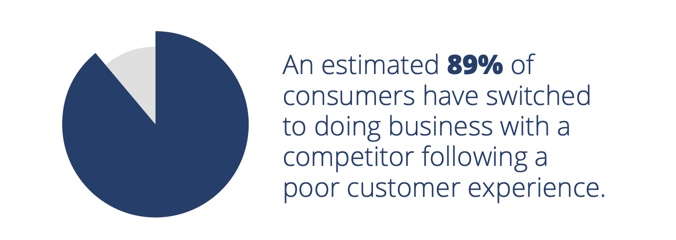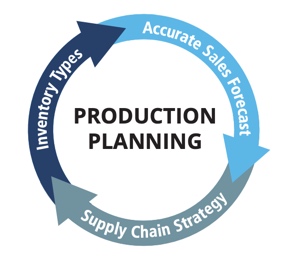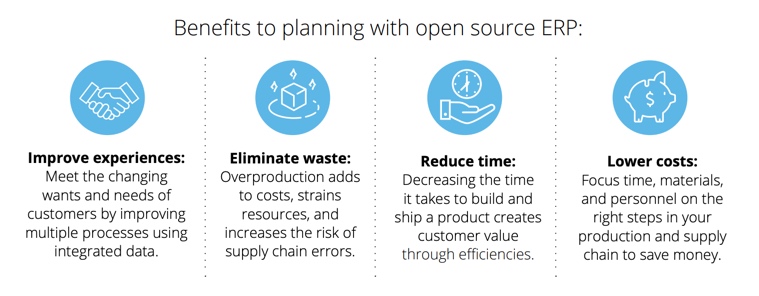Introduction
Every year, manufacturers of all sizes lose millions due to out-of-stock products and overstocked inventory. This causes missed customer commitments as well as diminished margins. With accurate forecasting, based on integrated sales and product data, companies can effectively plan and predict future demand, optimize inventory levels, and nimbly respond to market disruptions and volatility.
Companies that take a holistic approach to planning, combined with integrating disconnected systems with an open source ERP, can use accurate data to identify the right opportunities for improvement and take the guesswork out of predicting demand. They can create visibility into the value stream—mapping out every step of the process from the customer to production, assembly, packaging, and shipping. They can find their pacesetter to pinpoint needed inventory, the impacts on the supply chain, as well as where and how to boost time and obtain resources to meet demand spikes.
Ultimately, integrated planning allows manufacturers to know their customers at a deeper level. They can produce the right product at the right time to meet customer commitments, eliminating waste, reducing costs, improving on-time-delivery, and increasing profits. They can also increase visibility into the health of the organization to grow and maintain a competitive advantage even during turbulent times.
The challenge of optimizing inventory
Whether you work in food and beverage, apparel, appliances, computer, electrical, or any other manufacturing sector, the never-ending dilemma is: how do you maintain the right amount of inventory and production, meet customer commitments, and make money?
That’s because most manufacturers struggle with excess, lost, and damaged inventory, especially when there have been disruptions to the supply chain and unpredictable peaks and valleys in consumer shopping. But the core challenges preclude current events; for instance, companies often struggle during the holiday season when orders spike dramatically; or, if you’re a B2B manufacturer, when orders increase at the end of the fiscal year.
With the volatility of inventory comes the issue of service quality and customer experience. Businesses that struggle to meet customer demands and deliver on-time will turn off a modern-day customer, because they lack the brand loyalty of buyers from just a few years ago.

An estimated 89% of consumers have switched to doing business with a competitor following a poor customer experience. Moreover, if a customer is not satisfied, 13% will tell 15 or more people that they are unhappy. Today’s customers want products fast, and their shopping preferences can change quickly and dramatically, making it challenging to ensure you have the right amount of manufactured goods to meet customer expectations.
This is where forecasting comes into play. The challenge for most companies with their demand planning involves how they analyze historical sales and transaction data and whether they operate using siloed technology, people, and processes. Many companies look at sales data in one system to predict their future demand without ever sharing or consulting product information to estimate inventory replenishment and ordering activities.
Holistic forecasting begins with the customer
| To meet customer demand, you’ll want to use a forecasting cycle. And you’ll want to take a holistic approach that includes an accurate sales forecast and supply chain strategy, including how much inventory you need and what the supply chain can do to provide that. This will consist of inventory types. With your sales, supply chain, and inventory data integrated, you’ll have the complete picture it takes to produce a successful production plan. |  |
You’ll want to keep each element of the plan aligned, focused, and simple to drive towards better production. Start by looking at historical sales data to identify highs and lows in your selling cycle by quarter, month, or any other appropriate time period. For instance, you could designate by the holiday season or summer months. In an open source ERP, that data can be located in your CRM, which is integrated with accounting, inventory, purchasing, manufacturing, and more. As part of building your forecast, consider additional variables such as marketing campaigns, new product developments, and other impacts on your future state.
Once you identify the sales spikes and dips, you can begin to level-load demand to bolster against disruptions to the market. You’ll want to take that sales intelligence and apply it to your production plan. And one way to do that efficiently involves a visual tool known as a value stream map.

Create visibility into your value stream
An important principle to embrace is value-stream mapping, which stems from lean management. Mapping your value stream provides a visual means to view the steps in a specific process so you can easily quantify time and volume. It helps organizations understand the flow of materials as they progress through the process.
You can start with a simple pen and paper. Begin with your customer because they drive the production and resources needed to meet demand. Then draw out the current state, including elements from sourcing to production, assembly, and packaging. You can also attribute the staffing, resources, and time involved in each step. Your sales team will give you an average of what they’ll need to meet predicted customer commitments.

This will give your Takt time, which is the rate (month, week, and day) at which you need to complete a product to meet customer demand in the normal buy cycle. Once you have the proper product Takt time, you will look at the supply chain and your suppliers to understand what you’ll need from them to meet your Takt time and customer commitments. This will drive providing accurate forecasts of what you’ll need in a timely manner. Again, having your sales, warehouse, inventory, supplier, and other data in an integrated, open solution equates to greater transparency and accessibility for both internal and external stakeholders.
Know your pacemaker
As part of your value stream map, you’ll want to identify your pacemaker, which is the single point where the entire production process is scheduled. You want to identify the operation that takes the most time and therefore produces the least amount in the same time frame.
For example, you might be an equipment manufacturer who, on any given day, can build 10 components, assemble 20 products, and package 30 products a day. This means that in 24 hours, the most amount of completed products you can ship is 10 because you can only build 10 components.

You can then go back to your Takt time (the number of products you need to produce to meet customer demand) to ensure you’re not at risk of missing future demand. For instance, if you have a forecasted Takt time of 15 sales a day, then the number of components you can build in a day becomes a potential area of risk you will want to address. Now you have the intelligence needed to drive meaningful business decisions into ways to increase building capacity, whether it involves adding additional resources, such as adding another production line, or more dedicated staffing hours in a 24-hour period.
Identifying your pacesetter ultimately helps remove complexity. How? If you try to capacity plan every element and step of production and labor, you’ll create waste because you’ll increase the wrong steps in your value stream. Your pacesetter identifies where to adjust using the right information stored in your enterprise ERP.
Drive improvements back up the value stream
As you map your value chain and understand your inventory demand, you can go back to view anticipated seasonal spikes. Perhaps in December, you have two operations at risk—building and assembly. That can create a warehouse problem because you might have to store a dramatic increase in outsourced materials for just a short duration. And increasing the number of materials you keep in the warehouse raises the risk of damaged or lost items and impacts cost.

Through the holistic process of creating a value stream map, you identify what and when materials and inventory are needed by quarter, month, week, and day. You can anticipate what an increase in the supply chain means for warehouse space and resource planning. You can also make better business decisions, such as when to carry increased inventory and how to react when suppliers face disruptions, like COVID-19, so you can adjust using real data to keep their inventory levels correct. By doing so, you’ll improve your overall inventory management, which drives efficiencies upstream in your supply chain.
In addition, when you know your product data and your demand on a daily or weekly basis, you can give your suppliers more accurate information ahead of time, which ties back to the value of your forecasting and helps create better vendors in the supply chain. If your suppliers know what they need to produce in advance, they make better decisions, such as when to build a bulk shipment based on a push model.
Master your demand forecasting
With complete data and transparency, tackling sales and product forecasting becomes a lot easier. It’s just a matter of taking a holistic approach and breaking down silos using technology. And while there are many ways to improve forecasting, one proven method involves evaluating and mapping the organization’s current state, getting the right information into the system, and improving methods moving forward to impact the future state.






